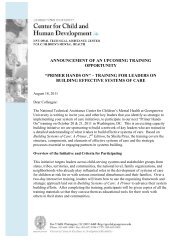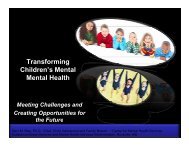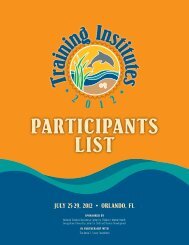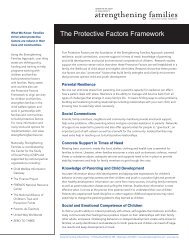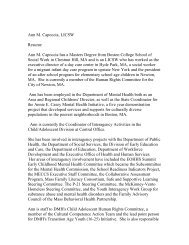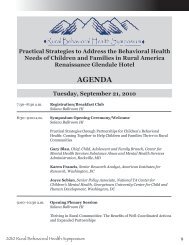Training Institutes 2012 - National Technical Assistance Center for ...
Training Institutes 2012 - National Technical Assistance Center for ...
Training Institutes 2012 - National Technical Assistance Center for ...
You also want an ePaper? Increase the reach of your titles
YUMPU automatically turns print PDFs into web optimized ePapers that Google loves.
RESOURCES<br />
Definition of Family-Driven Care<br />
DEFINITION OF FAMILY-DRIVEN CARE<br />
Family-driven means families have a primary decision making role in the care of their own children<br />
as well as the policies and procedures governing care <strong>for</strong> all children in their community, state,<br />
tribe, territory, and nation. This includes:<br />
• Choosing culturally and linguistically competent supports, services, and providers;<br />
• Setting goals;<br />
• Designing, implementing, and evaluating programs;<br />
• Monitoring outcomes; and<br />
• Partnering in funding decisions.<br />
GUIDING PRINCIPLES OF FAMILY-DRIVEN CARE<br />
1. Families and youth, providers, and administrators embrace the concept of sharing decisionmaking<br />
and responsibility <strong>for</strong> outcomes.<br />
2. Families and youth are given accurate, understandable, and complete in<strong>for</strong>mation necessary to<br />
set goals and to make in<strong>for</strong>med decisions and choices about the right services and supports <strong>for</strong><br />
individual children and their families.<br />
3. All children, youth, and families have a biological, adoptive, foster, or surrogate family voice<br />
advocating on their behalf and may appoint them as substitute decision makers at any time.<br />
4. Families and family-run organizations engage in peer support activities to reduce isolation,<br />
gather and disseminate accurate in<strong>for</strong>mation, and strengthen the family voice.<br />
5. Families and family-run organizations provide direction <strong>for</strong> decisions that impact funding <strong>for</strong><br />
services, treatments, and supports and advocate <strong>for</strong> families and youth to have choices.<br />
6. Providers take the initiative to change policy and practice from provider-driven to family-driven.<br />
7. Administrators allocate staff, training, support, and resources to make family-driven practice<br />
work at the point where services and supports are delivered to children, youth, and families and<br />
where family and youth run organizations are funded and sustained.<br />
8. Community attitude change ef<strong>for</strong>ts focus on removing barriers and discrimination created<br />
by stigma.<br />
9. Communities and private agencies embrace, value, and celebrate the diverse cultures of their<br />
children, youth, and families and work to eliminate mental health disparities.<br />
10. Everyone who connects with children, youth, and families continually advances their own<br />
cultural and linguistic responsiveness as the population served changes so that the needs of the<br />
diverse populations are appropriately addressed.<br />
Federation of Families <strong>for</strong> Children’s Mental Health, <strong>2012</strong>. Retrieved from http://ffcmh.org/family-driven-definition<br />
162 <strong>Training</strong> <strong>Institutes</strong> 2010



